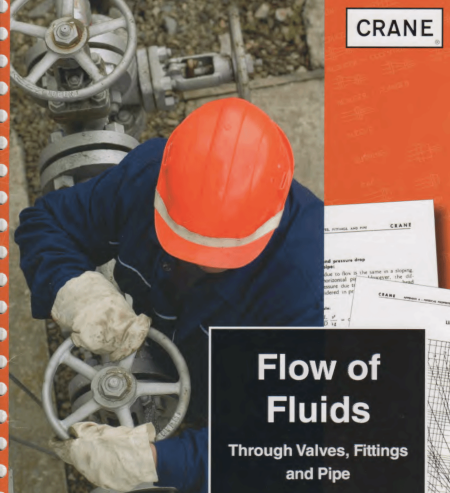Pipe Flow Crane

Description
Pipe and Fittings Flowing Pressure Drop Calculation based on Crane Flow of Fluids method
Calculate flowing pressure drop through any single stream pipe system comprising a wide range of pipe, fittings and valves of up to four different pipe sizes. Piping systems can be short and complex spools or very long pipelines.
Standard ASME B36.10 and B36.19 carbon steel pipe sizes are included and called up automatically but can also be manually entered by the user. Manual entry can easily be used to accommodate for piping from alternative materials and dimensions.
A full range of pipe fittings and valves from the Crane book are included plus a wide range of vendor valves is included and can be added to by the user.
Piping system inlet and outlet ends can readily be configured to represent gravity storage tanks, pressure vessels, pipe branches or pump/compressor nozzles.
Fluids transported can be any liquid or gas with the limitation that constant temperature and constant density are assumed. However, changes in temperature and density can easily be accommodated by using density and viscosity at the mean flowing pressure and temperature. For gases pressure drops can be up to 10% without correction or up to 40% if mean properties are used.
Fluid properties for water and for dry air are included and called up automatically but can also be manually entered.
The calculation by default calculates using a given upstream pressure and flowrate to find the resulting downstream pressure. However, it is also configured to automatically solve for the upstream pressure, flowrate or flowing velocity.
Key calculation formulas are presented using XLC so the methodology used is clear. A number of simple macros are used to calculate the Moody friction factor, various interpolated values and to iterate for some of the solutions. If prompted users should ‘enable macros’ when using the application.
Within the temperature and density limitations set by the Crane method the calculation accuracy has been verified against more complex calculation methods and has proven reliable over many years of use.
All user entry cells are highlighted to guide the user. The calculation is set up to be used with all worksheets protected (no password) in order to maintain the integrity of the calculations.
NOTE:
The Crane Flow of Fluids method is a widely used approach for calculating the pressure drop in piping systems. The method is based on the concept of equivalent length, which allows for the pressure drop in fittings and valves to be expressed as an equivalent length of straight pipe. The total pressure drop in the system is then calculated using the Darcy-Weisbach equation.
Here's a step-by-step procedure for calculating the pressure drop in a pipe and fittings using the Crane Flow of Fluids method:
-
Calculate the pipe's flow velocity (v) based on the flow rate (Q) and pipe cross-sectional area (A): v = Q / A.
-
Determine the pipe's inside diameter (D) and pipe material.
-
Calculate the pipe's Reynolds number (Re) using the formula: Re = (D * v * ?) / ?, where ? is the fluid density, and ? is the fluid dynamic viscosity.
-
Obtain the pipe's friction factor (f) using the Colebrook-White equation or the Moody diagram, based on the Reynolds number (Re) and the pipe's relative roughness (?/D).
-
Calculate the pressure drop (?P_pipe) in the straight pipe sections using the Darcy-Weisbach equation: ?P_pipe = f * (L/D) * (? * v²) / 2, where L is the total length of the straight pipe sections.
-
Identify all fittings and valves in the piping system, and obtain their equivalent lengths (Leq) from the Crane Flow of Fluids Technical Paper No. 410 or manufacturer data.
-
Calculate the pressure drop (?P_fittings) in the fittings and valves using the Darcy-Weisbach equation: ?P_fittings = f * (?Leq/D) * (? * v²) / 2, where ?Leq is the sum of all equivalent lengths.
-
Add the pressure drop in the straight pipe sections (?P_pipe) and the pressure drop in the fittings and valves (?P_fittings) to obtain the total pressure drop (?P_total) in the piping system: ?P_total = ?P_pipe + ?P_fittings.
Keep in mind that the Crane Flow of Fluids method assumes steady, incompressible flow and is best suited for relatively simple pipe systems. For more complex systems or non-steady flow conditions, other methods or computational fluid dynamics (CFD) models may be necessary.
Calculation Preview
Full download access to any calculation is available to users with a paid or awarded subscription (XLC Pro).
Subscriptions are free to contributors to the site, alternatively they can be purchased.
Click here for information on subscriptions.
